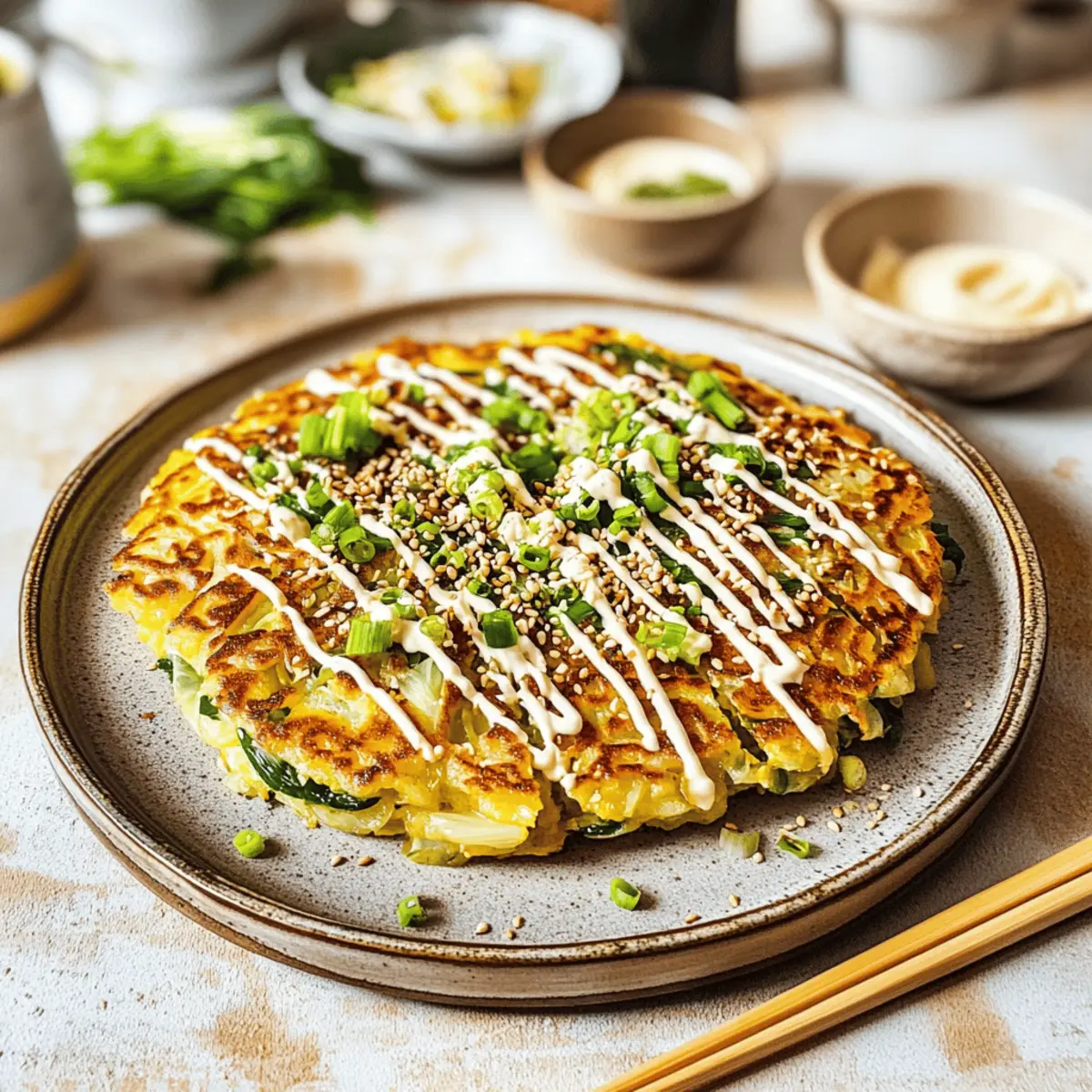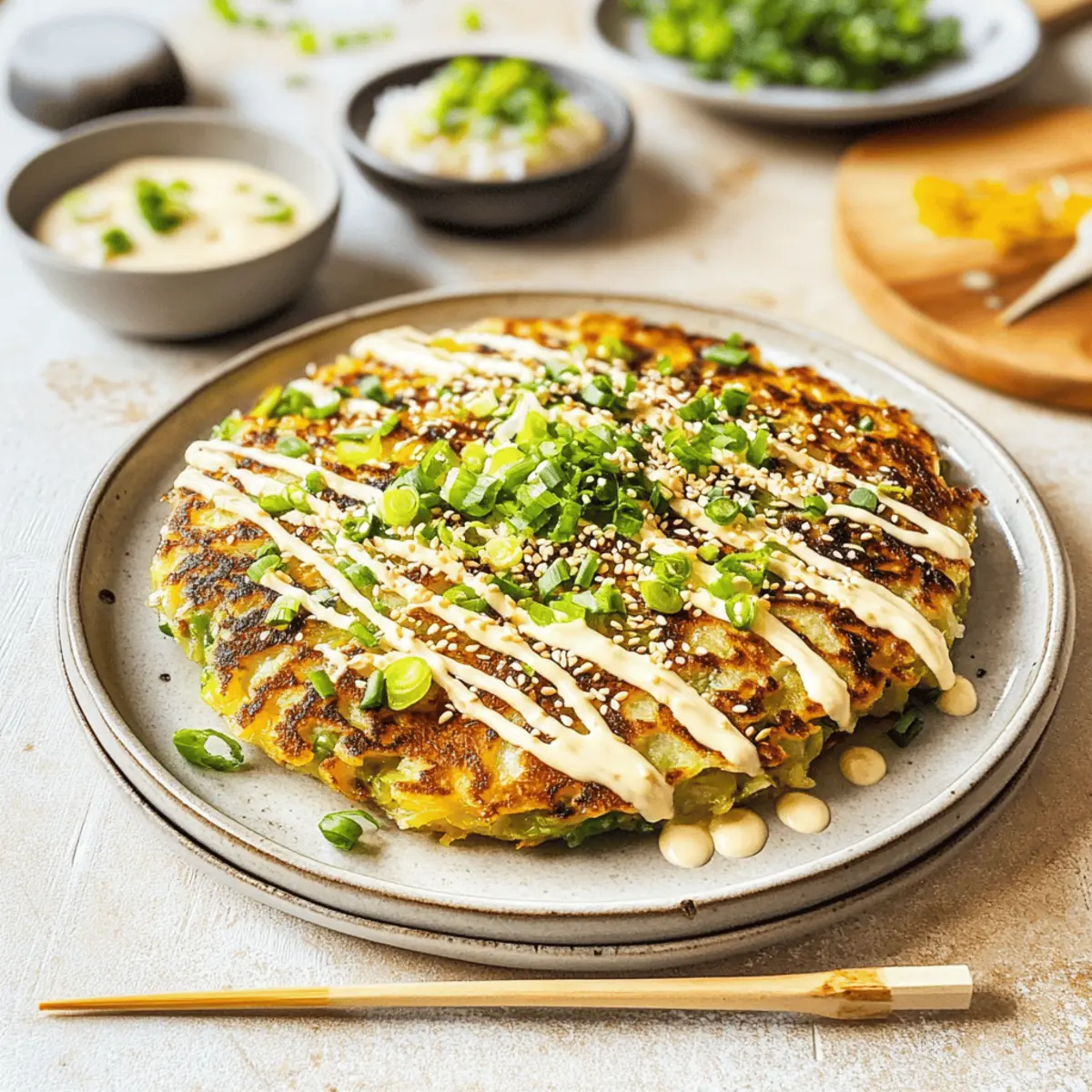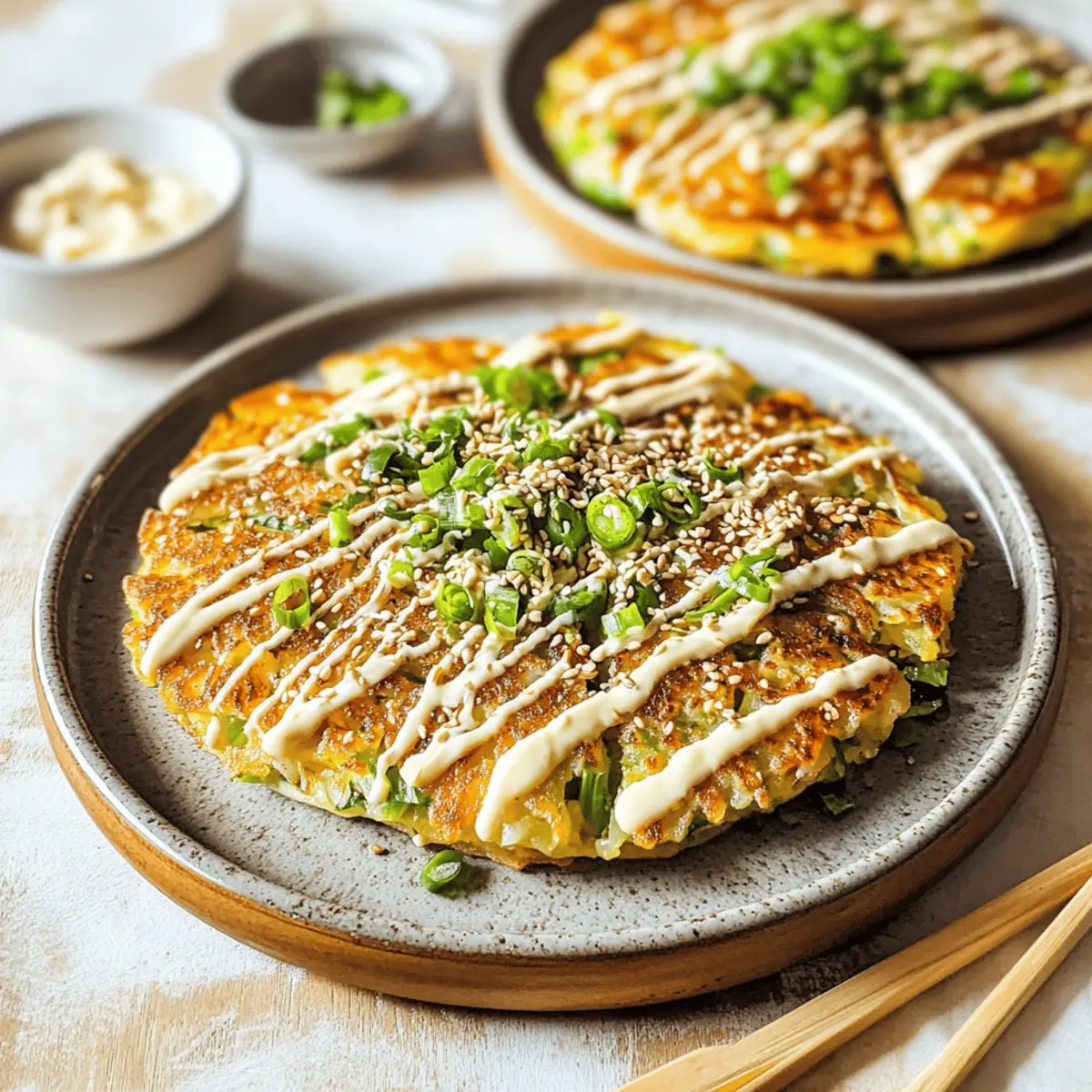As I flipped my first okonomiyaki, the aroma of sautéed cabbage wafted through my kitchen, instantly transporting me to the bustling streets of Japan. These Japanese cabbage pancakes are not only a fantastic way to use up whatever veggies you have lying around, but they also deliver a satisfying meal in just 20 minutes—perfect for anyone craving a quick yet wholesome dish. Packed with nutrients and customizable to suit any palate, these delightful pancakes are ideal for breakfast, lunch, or dinner. Whether you’re a seasoned chef or a busy home cook, this recipe will have you flicking flour around in joyful abandon. Ready to learn how to make your own deliciously fluffy okonomiyaki? Let’s dive in!

Why are Japanese Cabbage Pancakes so enticing?
Crispiness Meets Fluffiness: Each bite of these Japanese cabbage pancakes offers a delightful contrast; crispy on the outside yet fluffy within.
Quick to Prepare: In just 20 minutes, you can whip up a meal that’s both delicious and healthy, making it perfect for busy weeknights.
Endless Customization: Add your favorite veggies—carrots, leeks, or even spicy peppers—for a personalized flavor profile that suits everyone at the table.
Healthy and Wholesome: Packed with nutrients and low in calories, these pancakes can easily fit into your diet while satisfying those comfort food cravings.
Family-Friendly Fun: Kids will love helping combine the ingredients, transforming dinner into a fun family activity! For more ideas, check out my delightful Fluffy Buttermilk Pancakes that are equally shareable.
Versatile Serving Options: Enjoy them hot or at room temperature, paired with a side of miso soup or a light salad for a complete meal.
Japanese Cabbage Pancake Ingredients
Unleash the flavor with these essential ingredients!
For the Batter
- Cabbage – Provides structure and the main flavor; can substitute with kale or bok choy for a different taste.
- Carrot – Adds sweetness and color; grated zucchini can be used for a lighter texture.
- Onion – Offers aroma and depth; green onions or shallots serve as good alternatives.
- Salt – Draws moisture from vegetables to improve texture.
- Eggs – Binds the mixture for stability; for a vegan option, substitute with flax eggs.
- Soy Sauce – Adds umami flavor; tamari can be used for gluten-free needs.
- Toasted Sesame Oil – Enhances flavor; olive oil may substitute, but it will alter the taste.
- All-Purpose Flour – Provides structure; gluten-free all-purpose flour works too.
- Oil for Frying – Prevents sticking; use neutral oil like canola or grapeseed.
For Toppings
- Japanese Mayonnaise – Adds a creamy element to each bite for an authentic touch.
- Toasted Sesame Seeds – Enhance flavor and add a delightful crunch.
- Pickled Ginger – Offers a tangy contrast that brightens the dish.
- Sliced Scallions – Bring freshness and color to the presentation.
- Cilantro – Adds a burst of flavor that complements the savory pancakes beautifully.
Now you’re well-equipped to create your very own Japanese cabbage pancake masterpiece! Enjoy crafting and indulging in this delightful dish.
Step‑by‑Step Instructions for Japanese Cabbage Pancake
Step 1: Prep Vegetables
Begin by shredding the cabbage, carrot, and onion; place them in a colander. Sprinkle salt over the veggies and let them sit for about 10 minutes to draw out excess moisture, which helps improve the texture of your Japanese cabbage pancake. You’ll know they’re ready when they start to soften.
Step 2: Prepare Batter
In a large mixing bowl, whisk together the eggs, soy sauce, and toasted sesame oil until well combined. Gradually add in the all-purpose flour, mixing until you achieve a smooth batter. This mixture will serve as the foundation for your Japanese cabbage pancake, creating a binding element that holds all the flavors together.
Step 3: Mix Vegetables and Batter
After draining the moisture from the vegetables, gently fold them into the batter until everything is evenly coated. The vibrant colors from the cabbage, carrot, and onion will brighten the batter. This is the magic moment where your Japanese cabbage pancake begins to take shape, bursting with wholesome goodness!
Step 4: Heat Skillet
Place a non-stick skillet or well-seasoned cast iron skillet over medium-high heat and add a drizzle of cooking oil. Allow the pan to heat for about 1-2 minutes; you’ll know it’s ready when a drop of water sizzles upon contact. This is crucial for achieving that perfect crispy outer layer on your Japanese cabbage pancake.
Step 5: Cook Pancakes
Pour the battered mixture into the skillet to form your pancake. For a larger pancake, use all the batter, or for individual servings, scoop out half or a quarter cup at a time. Cook for approximately 5 minutes, until the bottom turns golden brown. Carefully flip and let the other side cook for another 3-4 minutes until it matches in color and becomes crispy.
Step 6: Rest and Serve
Once cooked, remove the pancake from the skillet and let it rest for a minute to set. This helps the flavors meld together beautifully. Serve your Japanese cabbage pancake warm, topped with your favorite accompaniments like Japanese mayonnaise, sesame seeds, or pickled ginger for that extra flair!

What to Serve with Japanese Cabbage Pancakes
Looking to create the perfect meal that complements your delicious okonomiyaki? Let’s explore some delightful options!
-
Miso Soup: A warm bowl of miso soup brings comforting flavors that enhance the savory pancakes, making for a wholesome pairing.
-
Sesame Cucumber Salad: Crisp and refreshing, this salad adds a crunchy contrast and balances the richness of the pancakes.
-
Edamame: Lightly salted edamame pods make a great finger food. Their earthy flavor complements okonomiyaki beautifully, adding a fun, interactive element to your meal.
-
Sweet Chili Sauce: Drizzling sweet chili sauce over the pancakes offers a delightful kick and tangy sweetness that tantalizes the taste buds and takes each bite to another level.
-
Steamed Rice: A small bowl of steamed jasmine or brown rice provides a neutral backdrop for the vibrant flavors of the pancakes, making it a satisfying side.
-
Sake: Enjoying chilled or warm sake brings an authentic Japanese dining experience, enhancing the overall meal vibe with each sip.
-
Matcha Green Tea: A soothing cup of matcha green tea pairs wonderfully, cleansing the palate while adding a unique, earthy depth to your dining experience.
How to Store and Freeze Japanese Cabbage Pancakes
Fridge: Store leftover pancakes in an airtight container in the refrigerator for up to 3 days. Reheat gently on a skillet or in the microwave for a quick meal.
Freezer: For longer storage, place cooled pancakes in a single layer on a baking sheet, then freeze until solid. Transfer to a freezer bag for up to 1 month.
Thawing: When ready to enjoy again, thaw the frozen pancakes in the refrigerator overnight.
Reheating: To reheat, warm them in a skillet over medium heat until heated through, or microwave for about 30-60 seconds. Enjoy the deliciousness of your Japanese cabbage pancakes!
Make Ahead Options
These Japanese cabbage pancakes are perfect for meal prep enthusiasts! You can shred and salt the cabbage, carrot, and onion up to 24 hours in advance, allowing the veggies to draw moisture overnight for optimal texture. Once ready to cook, simply mix the drained vegetables into the batter you’ve prepared and keep it refrigerated for up to 3 days. For the best results, remember to gently fold the ingredients right before cooking to ensure the pancakes retain their fluffy texture. When you’re ready to serve, just heat your skillet and cook the pancakes until they’re golden brown—resulting in delicious, homemade okonomiyaki with minimal effort on busier nights!
Expert Tips for Japanese Cabbage Pancakes
Perfecting the Batter: Beat the eggs thoroughly before adding to achieve a light, fluffy texture in your pancakes.
Moisture Management: Don’t skip salting the vegetables; it’s essential to extract moisture for a better texture in your Japanese cabbage pancake.
Skillet Choice: Use a non-stick or well-seasoned cast iron skillet to prevent sticking and ensure easy flipping.
Heat Control: Maintain medium heat while cooking; too high a temperature can burn the outside while leaving the inside raw.
Experiment with Fillings: Feel free to add or substitute other vegetables, such as grated zucchini or bell peppers, to customize your Japanese cabbage pancake to suit your taste.
Japanese Cabbage Pancake Variations
Feel free to let your creativity shine and customize these delicious pancakes to suit your taste buds!
-
Dairy-Free: Use coconut milk instead of eggs for a rich and creamy texture. This will introduce a subtle sweetness, perfect for those avoiding dairy.
-
Gluten-Free: Swap out all-purpose flour for gluten-free flour blend. This ensures everyone at your table can enjoy these tasty pancakes without any worries.
-
Spicy Kick: Incorporate finely chopped jalapeños or spicy miso into the batter. This adds a delightful heat that pairs beautifully with the savory flavors.
-
Seaweed Flavor: Mix in crumbled nori or wakame for an authentic taste. This twist not only enhances flavor but gives a lovely oceanic aroma.
-
Extra Veggies: Add grated zucchini or squash for an added layer of nutrition and a unique flavor twist. It’s a great way to pack more veggies into these pancakes.
-
Herb Infusion: Fresh herbs like cilantro or basil can be mixed into the batter for a refreshing kick. This not only brightens the flavor but adds a gorgeous touch of color.
-
Sautéed Fillings: Before mixing, sauté leeks or mushrooms, and fold them into the batter for a delicious depth of flavor. This can elevate your Japanese cabbage pancakes even further.
-
Asian Slaw Topping: Top the pancakes with an Asian slaw made of shredded carrots, cabbage, and a sesame dressing for added crunch and freshness.
By exploring these twists, you can create a personalized meal everyone will love. For additional pancake inspiration, try my scrumptious Fluffy Buttermilk Pancakes that are perfect for breakfast or brunch!

Japanese Cabbage Pancake Recipe FAQs
How do I choose the right cabbage for my Japanese cabbage pancakes?
Absolutely! When selecting cabbage, look for heads that are firm and heavy for their size, with crisp leaves and no dark spots all over. If you want to try something different, bok choy or kale can also make a delightful substitution!
What’s the best way to store leftover Japanese cabbage pancakes?
You can store any leftovers in an airtight container in the fridge for up to 3 days. When you’re ready to savor them again, simply reheat them gently on a skillet to bring back that wonderful texture.
Can I freeze Japanese cabbage pancakes, and how?
Very much so! To freeze, let your pancakes cool completely. Then, place them in a single layer on a baking sheet and freeze until solid. Afterward, transfer them to a freezer bag and they will keep well for up to 1 month. When you crave them again, thaw in the refrigerator overnight and reheat before serving.
What should I do if my pancake mixture is too runny?
If you find your batter is too runny, don’t panic! You can simply add a little more all-purpose flour—start with a tablespoon at a time—until you achieve a thicker consistency. This will ensure your pancakes hold together perfectly while cooking.
Are there any dietary considerations for pets regarding Japanese cabbage pancakes?
While the main ingredients in Japanese cabbage pancakes are safe for dogs and cats in small amounts, it’s best to avoid sharing them. Ingredients like soy sauce can be high in sodium. Always check with your veterinarian before introducing new foods to your pet’s diet.
What if my pancakes are burning on the outside but raw inside?
To avoid this common mistake, ensure you’re cooking on medium heat. If the temperature is too high, consider lowering it. Additionally, make sure to allow a sufficient time for cooking each side so they become perfectly golden brown inside and out. Enjoy the cooking journey!

Savory Japanese Cabbage Pancake: Quick, Healthy Delight
Ingredients
Equipment
Method
- Begin by shredding the cabbage, carrot, and onion; place them in a colander. Sprinkle salt over the veggies and let them sit for about 10 minutes to draw out excess moisture.
- In a large mixing bowl, whisk together the eggs, soy sauce, and toasted sesame oil until well combined. Gradually add in the all-purpose flour to achieve a smooth batter.
- After draining the moisture from the vegetables, gently fold them into the batter until everything is evenly coated.
- Place a non-stick skillet over medium-high heat and add a drizzle of cooking oil. Allow the pan to heat for 1-2 minutes until a drop of water sizzles.
- Pour the batter into the skillet, cooking for approximately 5 minutes until the bottom is golden brown. Carefully flip and cook for another 3-4 minutes.
- Once cooked, remove the pancake from the skillet and let it rest for a minute. Serve warm topped with Japanese mayonnaise, sesame seeds, or pickled ginger.

